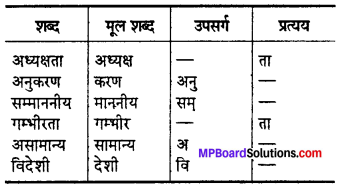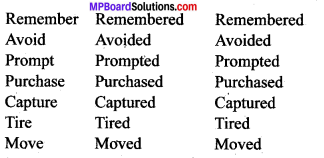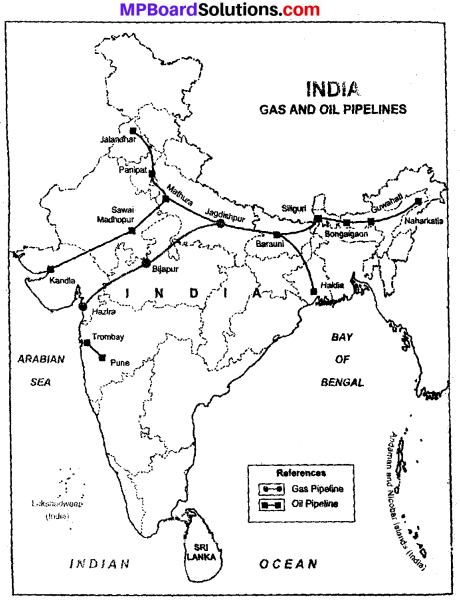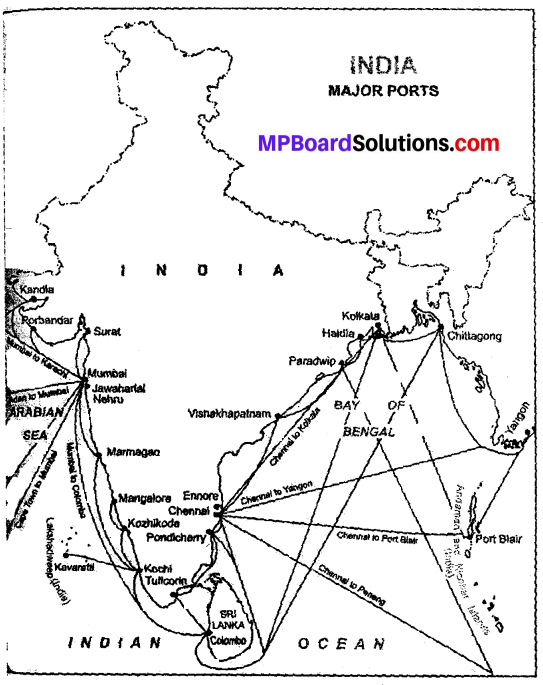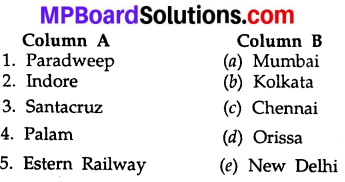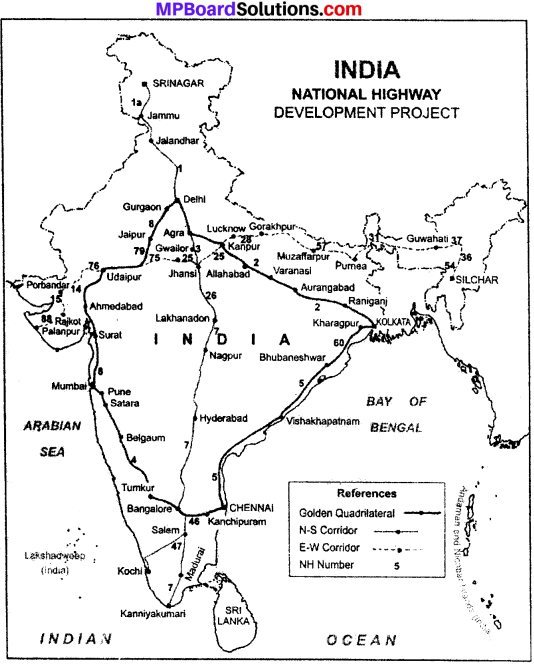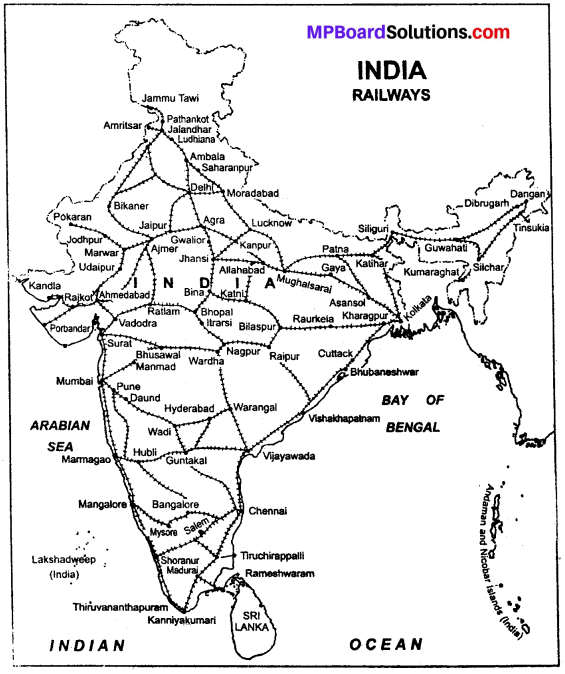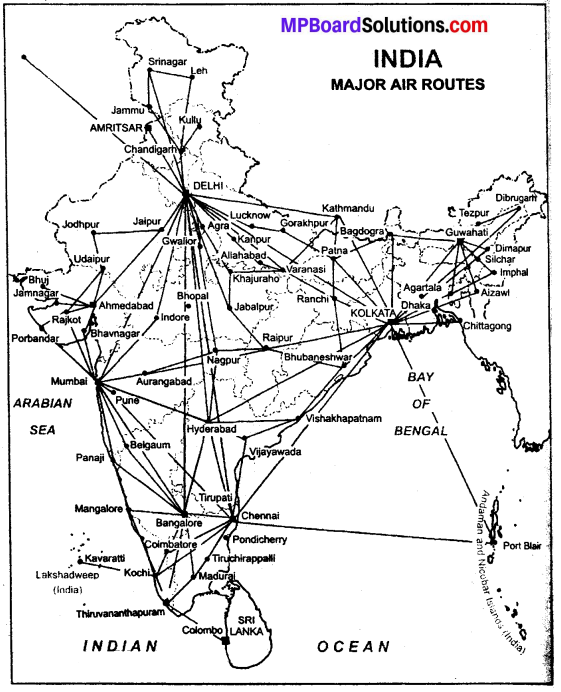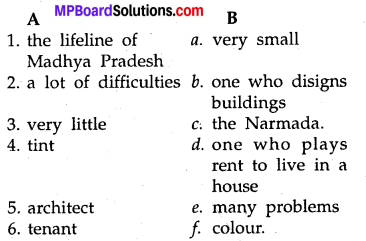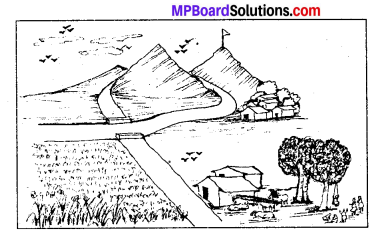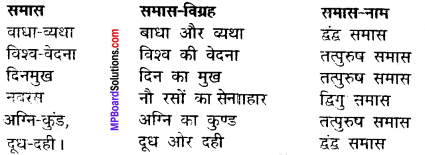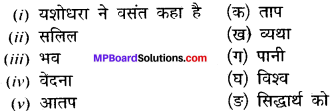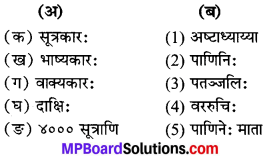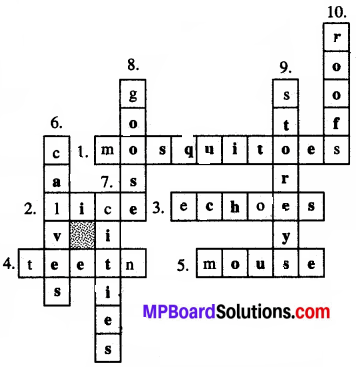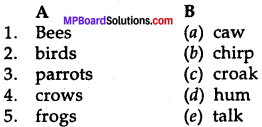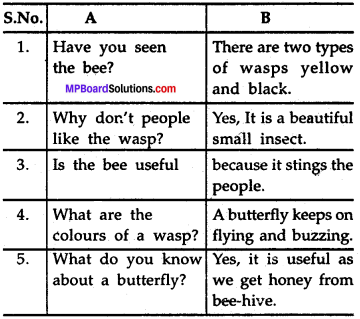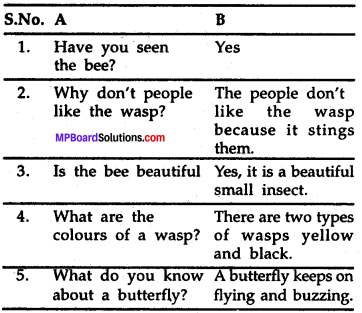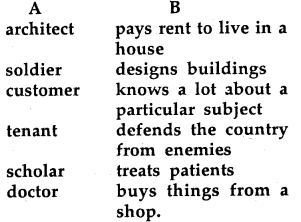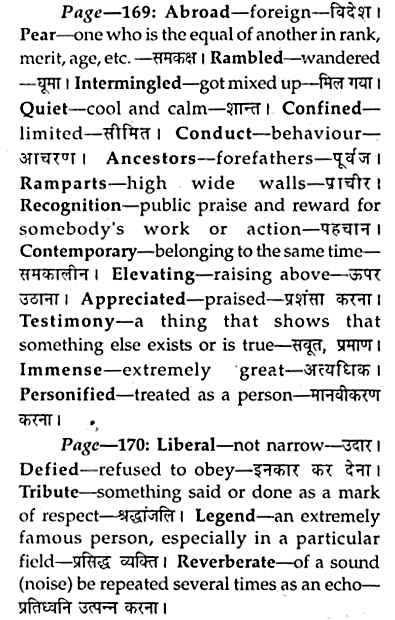MP Board Class 8th Sanskrit Solutions Surbhi Chapter 19 प्रियदर्शिनी इन्दिरा
MP Board Class 8th Sanskrit Chapter 19 अभ्यासः
Class 8 Sanskrit Chapter 19 MP Board प्रश्न 1.
एकपदेन उत्तरं लिखत(एक शब्द में उत्तर लिखो-)
(क) इन्दिरायाः भाषणानि कीदृशानि आसन्? (इन्दिरा के भाषण कैसे थे?)
उत्तर:
ऊर्जस्वलानि। (तेजस्वी)
(ख) इन्दिरायाः उच्चशिक्षा कुत्र अभवत्? (इन्दिरा की उच्च शिक्षा कहाँ हुई?)
उत्तर:
ऑक्सफोर्ड विश्वविद्यालये। (ऑक्सफोर्ड विश्वविद्यालय में।)
(ग) नेहरूः स्वपुत्रीं कथं द्रष्टुमैच्छत्? (नेहरू अपनी पुत्री को कैसा देखना चाहते हैं?)
उत्तर:
ऊर्जस्वलाम्। (तेजस्वी)
(घ) इन्दिरा कुत्र भारतीयसेनाम् प्रेषितवती? (इन्दिरा ने कहाँ भारतीय सेना को भेजा?)
उत्तर:
बङ्ग्लादेशम्। (बंग्लादेश में)
(ङ) इन्दिरायाः का उद्घोषणा आसीत्? (इन्दिरा की क्या उद्घोषणा थी?)
उत्तर:
दरिद्रतामपनय। (दरिद्रता हटाओ)
Sanskrit Class 8 Chapter 19 MP Board प्रश्न 2.
एकवाक्येन उत्तरं लिखत(एक वाक्य में उत्तर लिखो-)
(क) दिवङ्गतापि का अस्माकं कृते वर्तमानेवास्ति? (मरकर भी कौन हमारे लिए उपस्थित ही है?)
उत्तर:
दिवङ्गतापि इन्दिरा अस्माकं कृते वर्तमानेवास्ति। (मरकर भी इन्दिरा हमारे लिए उपस्थित ही है।)
(ख) इन्दिरायाः जन्म कदा अभवत्? इन्दिरा का जन्म कब हुआ?)
उत्तर:
इन्दिरायाः जन्म १९१७ तमे ख्रिस्ताब्दे अभवत् (इन्दिरा का जन्म 1917 वीं ईस्वी में हुआ।)
(ग) इन्दिरायाः जन्म कुत्र अभवत्? (इन्दिरा का जन्म कहाँ हुआ?)
उत्तर:
इन्दिरायाः जन्म प्रयागनगरे अभवत्। (इन्दिरा का जन्म प्रयाग नगर में हुआ।)
(घ) जवाहरलालनेहरुः किं कुर्वन् कारागारमगच्छत्? (जवाहरलाल नेहरू क्या करते हुए जेल गये?)
उत्तर:
जवाहरलालनेहरुः स्वतन्त्रतायै आन्दोलनं कुर्वन् कारागारमगच्छत्। (जवाहरलाल नेहरू स्वतन्त्रता के लिए आन्दोलन करते हुए जेल गए।)
(ङ) इन्दिरायाः समाधिस्थलं केन नाम्ना प्रसिद्धमस्ति? (इन्दिरा का समाधि स्थल किस नाम से प्रसिद्ध है?)
उत्तर:
इन्दिरायाः समाधिस्थलं ‘शक्तिस्थलम्’ इति नाम्ना प्रसिद्धमस्ति। (इन्दिरा का समाधिस्थल ‘शक्तिस्थल’ नाम से प्रसिद्ध है।)
Mp Board Class 8 Sanskrit Solution Chapter 19 प्रश्न 3.
रिक्तस्थानानि पूरयत(रिक्त स्थान भरो-)
(क) ………. इन्दिरायाः पिता आसीत्।
(ख) सर्वे ………. तत्रागच्छन्।
(ग) तया ……….. नाम्नी बालकानां सङ्घटना कृता।
(घ) ……… सहयोगेन बङ्ग्लादेशः स्वतन्त्रः जातः।
(ङ) सर्वे जनाः तां ……… इति रूपेण स्मरन्ति।
उत्तर:
(क) जवाहरलाल नेहरु
(ख) राष्ट्रियाः नेतारः
(ग) वानरसेना इति
(घ) भारतस्य
(ङ) शान्तिदूती।
Mp Board Class 8 Sanskrit Chapter 19 प्रश्न 4.
नामोल्लेखपूर्वकं समासविग्रहं कुरुत(नाम का उल्लेख करते हुए समास-विग्रह करो-)
(क) पुष्पमालाः
(ख) देशभक्तेः
(ग) सीमानिर्धारणम्
(घ) वीरगतिम्।
उत्तर:
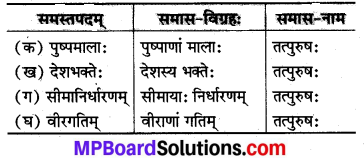
Class 8 Sanskrit Chapter 19 Mp Board प्रश्न 5.
नामोल्लेखपूर्वकं सन्धिविच्छेदं कुरुत(नाम का उल्लेख करते हुए सन्धि-विच्छेद करो-)
(क) दर्शनमनेकधा
(ख) स्वतन्त्रतान्दोलनस्य
(ग) तत्रागच्छन्
(घ) दरिद्रतामपनय
(ङ) द्रष्टुमैच्छत्।
उत्तर:
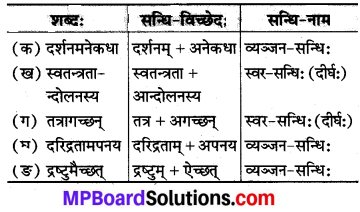
Mp Board 8th Class Sanskrit प्रश्न 6.
अधोलिखितशब्दान् आधृत्य वाक्यरचनां कुरुत (नीचे लिखे शब्दों के आधार पर वाक्य रचना करो-)
(क) कृते
(ख) समाप्य
(ग) कुर्वन्
(घ) सह
(ङ) अङ्गीकृत्य।
उत्तर:
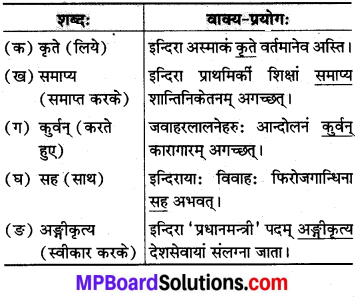
8 वीं कक्षा संस्कृत गाइड 2021 MP Board प्रश्न 7.
उचितं योजयत(उचित को जोड़ो-)
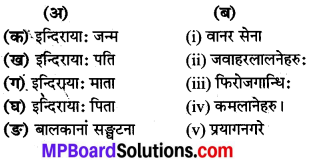
उत्तर:
(क) → (v)
(ख) → (iii)
(ग) → (iv)
(घ) → (ii)
(ङ) → (i)
Surbhi Sanskrit Book Class 8 Pdf Download MP Board प्रश्न 8.
भिन्नप्रकृतिकं शब्दं चिनुत (भिन्न प्रकृति के शब्द को चुनो-)
(क) इन्दिरा, पार्वती, अहिल्या, लक्ष्मीबाई।
(ख) अक्टूबरमासः, अगस्तमासः, चैत्रमासः, जूनमासः।
(ग) जलसेना, वानरसेना, थलसेना, वायुसेना।
(घ) प्रधानमन्त्री, वित्तमन्त्री, रक्षामन्त्री, महामन्त्री।
उत्तर:
(क) पार्वती
(ख) चैत्रमासः
(ग) वानरसेना
(घ) महामन्त्री।
प्रियदर्शिनी इन्दिरा हिन्दी अनुवाद
अस्माभिः प्रियदर्शिन्याः इन्दरायाः दर्शनमनेकधा कृतम्। कोटिजनैः तस्या ऊर्जस्वलानि भाषणानि श्रुतानि। सहस्रैः बालकैः तस्याः हस्ताभ्यां सस्नेहं प्रदत्ताः पुष्पमाला: गृहीता अतः दिवङ्गतापि सा देवी अस्माकं कृते वर्तमानेवास्ति।
तस्याः जन्म प्रयागनगरे १९१७ तमे ख्रिस्ताब्दे आनन्दभवनामके पैतृकगृहे अभवत्। जवाहरलाल नेहरुः तस्याः पिता कमलानेहरु च जननी अभवत्।
अनुवाद :
हम सबके द्वारा सुन्दर इन्दिरा का दर्शन कई बार किया गया। करोड़ों लोगों के द्वारा उनके तेजस्वी भाषणों को सुना गया। हजारों बालकों के द्वारा उनके हाथों से प्रेमपूर्वक दी गयी पुष्पमाला ली गई, इसलिए मरकर भी वह देवी हमारे लिए उपस्थित ही है।
उनका जन्म प्रयाग (इलाहाबाद) नगर में 1917 ईस्वी में आनन्दभवन नामक पैतृक घर पर हुआ। जवाहरलाल नेहरू उनके पिता और कमला नेहरू माता थीं।
इन्दिरायाः प्रारम्भिकी शिक्षा प्रयागे पूनानगरे चाभवत्। तेषु दिवसेषु आनन्दभवनं स्वतन्त्रतान्दोलनस्य केन्द्रमासीत्। सर्वे राष्ट्रियाः नेतारः तत्रागच्छन्। इन्दिरा तेभ्यः देशभक्तेः सङ्घर्षशीलतायाश्च संस्कारानगृह्णात्। प्राथमिकी शिक्षा समाप्य सा शान्तिनिकेतनमगच्छत्। तत्र गुरुदेवस्य रवीन्द्रनाथठाकुरस्य सान्निध्ये भारतीयसंस्कृतेः मानवप्रेम्णः च महतीं शिक्षाम् प्राप्नोत्। तस्याः उच्चशिक्षा इङ्ग्लैण्डदेशे आक्सफोर्डविश्वविद्यालये सम्पन्ना।
अनुवाद ;
इन्दिरा की प्रारम्भिक शिक्षा प्रयाग और पूना नगर में हुई। उन दिनों में आनन्दभवन स्वतन्त्रता आन्दोलन का केन्द्र था। सभी राष्ट्रीय नेता वहाँ आते थे। इन्दिरा ने उनसे देशभक्ति और संघर्षशीलता के संस्कारों को ग्रहण किया। प्राथमिक शिक्षा को समाप्त करके वह शान्ति निकेतन गयीं। वहाँ गुरुदेव रवीन्द्रनाथ ठाकुर के पास से भारतीय संस्कृति और मानव प्रेम की महान् शिक्षा प्राप्त की। उनकी उच्च शिक्षा इंग्लैण्ड देश में ऑक्सफोर्ड विश्वविद्यालय में सम्पन्न हुई।
जवाहरलालनेहरुः बहुधा स्वतन्त्रतायै आन्दोलनं कुर्वन् कारागारमगच्छत्। कारागारात् सः इन्दिरायै अनेकपत्राणि प्रेषितवान्। एतानि पत्रााणि ‘पुत्र्याः कृते पितुः पत्राणि’ इति नाम्ना पुस्तकरूपेण प्रसिद्धानि सन्ति। तेभ्यः ज्ञायते यत् नेहरुः स्वपुत्रीं विदुषीं दूरदर्शिनी ऊर्जस्वलां च द्रष्टुमैच्छत्।
अनुवाद :
जवाहरलाल नेहरू बहुत बार स्वतन्त्रता के लिए आन्दोलन करते हुए जेल गये। जेल से उन्होंने इन्दिरा के लिए अनेक पत्र भेजे। ये पत्र ‘पुत्री के लिए पिता के पत्र’ इस नाम से पुस्तक के रूप में प्रसिद्ध हैं। उनसे जाना जाता है कि नेहरू अपनी पुत्री को विदुषी, दूरदर्शिनी और तेजस्वी देखना चाहते थे।
इन्दिरायाः एते गुणाः प्रसिद्धाः सन्ति। स्वमातु: कमलानेहरुतः सत्यस्य शुद्धान्तःकरणस्य च शिक्षामलभत्। बाल्यकाले एव तया ‘वानरसेना’ इति नाम्नी बालकानां सङ्घटना कता। – तस्याः विवाहः फिरोजगान्धिना सहाभवत्। तौ दम्पती स्वाधीनतान्दोलने कारागारं गतवन्तौ। १९६० तमे खिस्ताब्दे तस्याः पतिः स्वर्गमगच्छत्।
अनुवाद :
इन्दिरा के ये गुण प्रसिद्ध है। अपनी माता कमला नेहरू से सत्य और शुद्ध अन्त:करण (मन) की शिक्षा को प्राप्त किया। बाल्यकाल में ही उनके द्वारा ‘वानरसेना’ नाम से बच्चों का संघटन किया गया।
उनका विवाह फिरोज गान्धी के साथ हुआ। वे दोनों पति-पत्नी स्वाधीनता के आन्दोलन में जेल गये। 1960 वीं ईस्वी में उनके पति (फिरोज गान्धी) स्वर्गवासी हो गये।
लालबहादुरशास्त्रिणः मृत्योरनतरं सा भारतस्य। ‘प्रधानमन्त्री’ अभवत्। तत्पदमङ्गीकृत्य सा देशसेवायां। सर्वभावेन संलग्ना जाता। अधिकोषाणां राष्ट्रियकरणम् भूतपूर्वराज्ञां विशिष्टाधिकाराणां समाप्तिः तेषां नैजधनदानस्य (प्रिवीपस) अन्तः भूमिसम्पत्योः सीमानिर्धारणं चेत्यादीनि कार्याणि तस्याः महत्त्वम् उद्भासयन्ति। बङ्ग्लादेशस्य मुक्तिसङ्ग्रामे भारतीयसेनां प्रेष्य तया अपूर्वसाहसे कृतम्। भारतस्य सहयोगेनैव बङ्गलादेशः स्वतन्त्रः जातः। सा जीवनपर्यन्तम् भारतस्य कल्याणाय निर्धानानामुत्थानाय च प्रयत्नमकरोत्। दरिद्रतामपनय इति तस्या उद्घोषणासीत्।
अनुवाद :
लालबहादुर शास्त्री की मृत्यु के बाद वह भारत की ‘प्रधानमन्त्री’ हुईं। उस पद को स्वीकार करके वह देश सेवा में पूर्णरूप से संलग्न हो गयीं। बैंकों का राष्ट्रीयकरण, भूतपूर्व राजाओं के विशिष्ट अधिकारों की समाप्ति, उनके अपने धन के दान का (प्रिवीपर्स) अन्त, भूमि और सम्पत्ति की सीमा का निर्धारण इत्यादि कार्य उनके महत्व को प्रकट करते हैं। बांग्लादेश की मुक्ति संग्राम में भारतीय सेना को भेजकर उनके द्वारा अपूर्व साहस किया गया। भारत के सहयोग से ही बांग्लादेश स्वतन्त्र हुआ। उन्होंने जीवन पर्यन्त भारत के कल्याण और निर्धनों के उत्थान के लिए प्रयत्न किया। दरिद्रता को दूर हटाओ’ यह उनका नारा था।
१९८४ तमस्य ख्रिस्ताब्दस्य अक्टूबरमासे एकत्रिंशदिनाङ्के सा एकस्य स्वरक्षकस्यैव गोलिकाभिः वीरगतिम् प्राप्नोत्।
सर्वे जनाः तां ‘शान्तिदूती’ इति रूपेण श्रद्धया स्मरन्ति। तस्याः समाधिस्थलं शक्तिस्थलमिति नाम्ना प्रसिद्धमस्ति।
अनुवाद :
1984 वी ईस्वी की अक्टूबर महीने की इक्तीस दिनांक की वह अपने एक रक्षक की ही.गोलियों से वीरगति को प्राप्त हुईं।
सभी लोग उनको ‘शान्तिदूती’ के रूप में श्रद्धा से याद करते हैं। उनका समाधि स्थल ‘शक्तिस्थल’ नाम से प्रसिद्ध है।
प्रियदर्शिनी इन्दिरा शब्दार्थाः
अनेकधा = कई बार। अधिकोषः = बैंक। कोटिजनैः = करोड़ों लोगों के द्वारा। सान्निध्ये = पास में। उर्जस्वलानि = तेजस्वी/तेजपूर्ण। उद्भासयन्ति = प्रगट करते हैं। सर्वभावेन = पूर्णरूप से। अपनय = दूर करो/हटाओ। अङ्गीकृत्य = स्वीकार करके। अवहन् ले जाते थे। अतीताः= भूतकाल की। उद्घोषणा = नारा।
